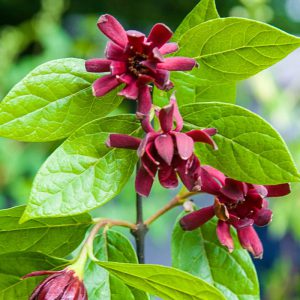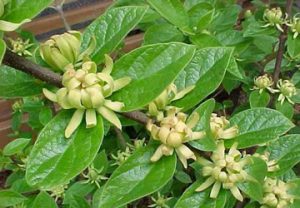Calycanthus floridus, Sweetshrub
Sweetshrub (Calycanthus floridus) is a great selection for moist locations. The flowers develop in midspring and have maroon to brown, strap-like petals, and a fragrance like that of strawberries. Historically, the petals were used as a sachet to freshen dresser drawers. Occasionally, they are used in potpourris. The leaves and fruits release an aroma when crushed. They can form prolific sprouts from the base of the plant.
Color Selections
This plant can be planted year-round provided they are watered frequently for several weeks after planting to ensure establishment. The shrub is native to Florida and can grow to a height reaching 6 to 9 feet tall with a spread of 6-12 feet. These scrubs are not fast growers yet; they reward you with pleasant aromatic red flowers in spring and summer. The variety ‘Athens’ suckers aggressive from the base with white flowers and yellow fall foliage and deep, pink variety ‘Michael Lindsey’ has wonderful fragrance and beautiful, shiny leaves.


Soil Conditions
These shrubs perform well in part shade to partial sun and will withstand occasionally wet-acidic to slightly alkaline, sand and loamy soil.
Unfortunately, this plant does not respond to salt conditions so space this beauty 36 to 60 inches apart in the landscape.
Sweetshrub an excellent candidate as a shrub border or for use as a screen. It can be sheared or thinned, depending on the desired use. Pruning and training the plant to several, upright stems can create an attractive specimen plant. It is an endangered plant in Florida.
Potential Disease
Be on the lookout for possible diseases that may occur on Sweetshrub including Bacterial crown gall (causes warty-looking growths on the stems near the soil line). There is no practical control measure for this problem. Destroy infected plants and avoid planting in contaminated soil. Powdery mildews fungi of different genera can cause a white coating on the leaves. Encourage air circulation, avoid wet foliage, and apply an occasional sulfur-based fungicide according to label directions during conditions of high humidity.
Resources:
FPS95/FP095: Calycanthus floridus Carolina Allspice, Sweetshrub (ufl.edu)
Source: UF/IFAS Pest Alert



